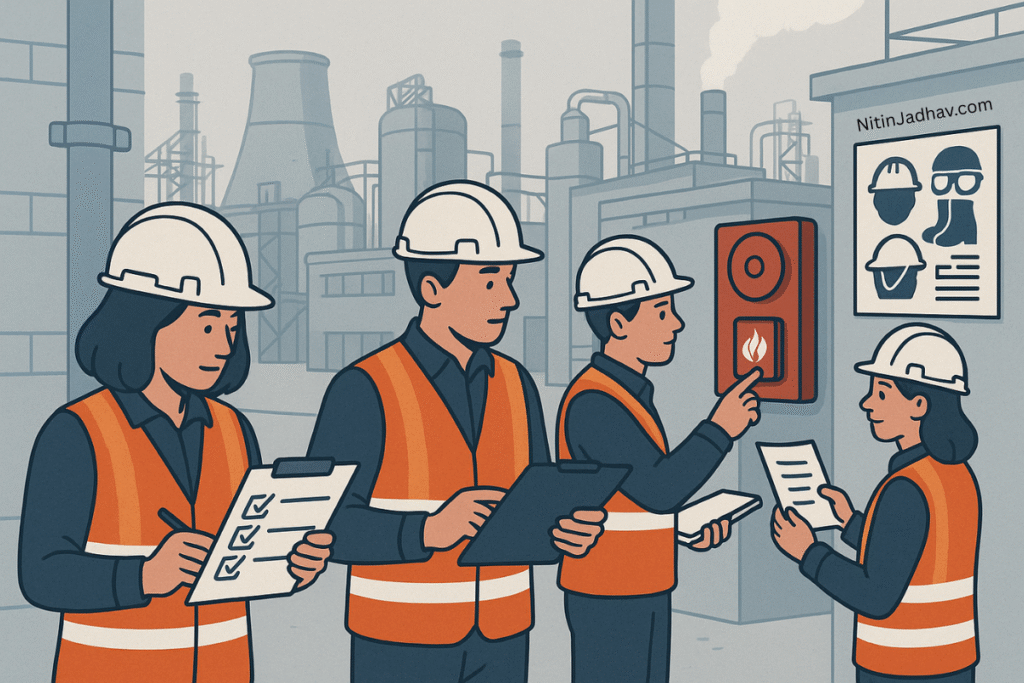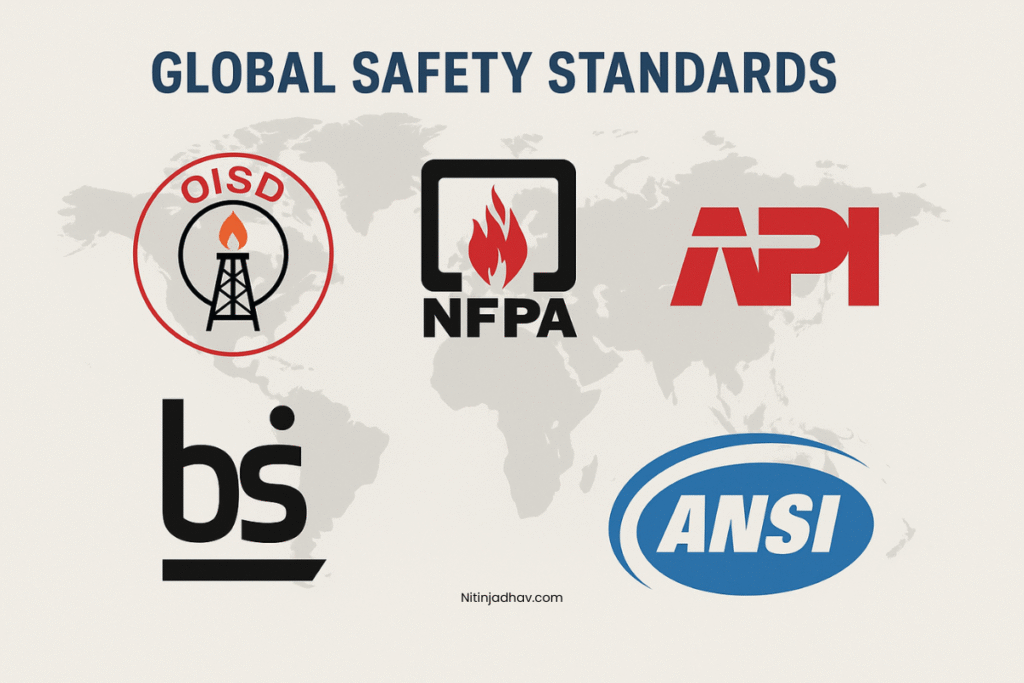Introduction
In high-risk industries such as oil & gas, petrochemicals, and hazardous chemical manufacturing, Safety Audits play a vital role in maintaining safe operations. A Safety Audit is a structured, systematic, and independent process for evaluating the effectiveness and compliance of an organization’s safety management systems. It uses predetermined checklists and recognized industry standards to identify hazards, evaluate controls, and recommend improvements.
Safety audits are widely used in both upstream and downstream sectors of the oil & gas industry, helping ensure compliance with national regulations such as Factories Act, Petroleum Rules, OISD Standards, and OSHA guidelines, among others.
This detailed guide explains the methodology, objectives, types, tools, and real-world importance of conducting safety audits for organizations managing hazardous operations.
What is a Safety Audit?
A Safety Audit is a formalized evaluation of how well an organization’s safety systems and processes align with best practices, legal requirements, and internal safety policies. It is often conducted using structured checklists and involves site inspections, documentation reviews, employee interviews, and observation of practices.
The main goals are:
- Identify unsafe conditions and practices
- Evaluate existing control measures
- Ensure legal compliance
- Propose corrective actions to improve safety performance
Safety audits are proactive, aiming to prevent incidents before they occur, unlike incident investigations which are reactive.
Objectives of a Safety Audit
The key objectives include:
- Evaluate Existing Safety Systems:
- Assess the adequacy of implemented safety systems against identified industrial hazards and risks.
- Review Health & Safety Management System:
- Examine policies, procedures, emergency response plans, and safety culture.
- Identify Health & Safety Risks:
- Evaluate risk related to process operations, hazardous chemical storage, handling, and transportation.
- Suggest Remedial Measures:
- Recommend cost-effective, practical solutions to mitigate and eliminate risks.
- Assess Firefighting Facilities:
- Inspect the capacity, coverage, and readiness of fire protection systems (hydrants, sprinklers, foam systems).
- Verify Legal Compliance:
- Review adherence to OISD guidelines, Explosive Rules, Factories Act, MSDS guidelines, etc.
- Critical Examination of Plant Operations:
- Detailed review of plant equipment, P&ID, hazardous zones, startup/shutdown procedures, control systems, and MOC (Management of Change).
- Review of Documentation:
- Operating Procedures, PPE matrix, Emergency Response Plan, PTW system, SOPs, training records.
- Review of Training and Accident Records:
- Evaluate incident logs, near miss reports, safety drills, and effectiveness of awareness programs.
- Surrounding Risk Evaluation:
- Understand potential domino effects or risk from adjacent industries and suggest protective controls.
Types of Safety Audits
1. Internal Safety Audit
- Conducted by an organization’s in-house safety team
- Usually more frequent (monthly/quarterly)
- Helps assess continual improvement and readiness for external reviews
2. External Safety Audit
- Conducted by certified third-party agencies or government-approved consultants (e.g., TPIAs approved by PNGRB)
- Annual or bi-annual
- Often required for statutory compliance, insurance purposes, or client mandates
Safety Audit Methodology
A typical safety audit follows these structured phases:
1. Pre-Audit Planning
- Define scope: e.g., process units, tank farms, warehouses
- Finalize audit team (internal/external)
- Review past audit reports
2. Checklist Preparation
- Based on national/international standards: OISD, IS 14489, OSHA, API RP 75
- Customized to process plant type and complexity
3. On-Site Execution
- Physical inspection
- Interviews with key plant personnel (operators, maintenance, EHS, security)
- Review of documents, training logs, SOPs
4. Findings and Observations
- Classify issues into:
- Unsafe acts
- Unsafe conditions
- Non-compliance
- Improvement areas
5. Risk Rating
- Each non-conformity is rated based on:
- Severity
- Likelihood
- Detectability
6. Recommendations
- Suggest practical engineering and administrative controls
- Assign target dates and responsible departments
7. Final Report Submission
- Submit a comprehensive audit report with photographs, root cause analysis (RCA), and action tracking mechanism
8. Follow-Up and Closure
- Review implementation of actions
- Verify effectiveness
- Conduct re-audit if necessary
Sample Safety Audit Checklist (Excerpt)
| Audit Area | Audit Points |
|---|---|
| Fire Protection | Availability, coverage, testing records of hydrants, foam monitors |
| Chemical Storage | Labeling, segregation, spill containment |
| Electrical Safety | Earth testing, overload protection, LT/HT panel housekeeping |
| Permit to Work | Validity, authorization, compliance with PTW types (hot, cold, confined space) |
| Training | Induction training, safety drills, toolbox talks, safety minutes |
Importance of Safety Audits in Oil & Gas Industry
- Prevention of Major Accidents
- Early detection of lapses in containment, instrumentation, or human error
- Regulatory Compliance
- Many Indian regulations and global standards (e.g., OISD, PNGRB, Factories Act, ISO 45001) mandate periodic audits
- Insurance and Liability Management
- Demonstrates due diligence in risk reduction to insurers
- Enhances Organizational Safety Culture
- Builds accountability, awareness, and ownership at all levels
- Supports Risk-Based Inspection (RBI)
- Aligns with RBI, HAZOP, QRA and LOPA to update risk register and SIL targets
Common Non-Conformities Observed During Safety Audits
- Missing MSDS or outdated versions
- Inadequate earthing and bonding in solvent storage
- Expired fire extinguishers or uncalibrated gas detectors
- Absence of ESD system coverage in critical areas
- Missing lockout-tagout (LOTO) procedures
- Poor ventilation in confined spaces
- No emergency evacuation drills conducted in last 6 months
Digital Tools & Software for Safety Audits
| Tool | Purpose |
| iAuditor by SafetyCulture | Mobile checklist and report automation |
| Intelex | EHS management software with audit module |
| BowTieXP | Risk and barrier audit integration |
| SAP EHS | Integration with ERP for audit tracking |
Safety Audit Reporting Format
- Cover Page (Company Name, Auditor Name, Date)
- Executive Summary
- Objectives & Methodology
- Observations (classified by severity)
- Photographic Evidence
- Root Cause Analysis
- Recommendations
- Compliance Scorecard
- Conclusion
- Action Plan with Target Dates
Internal Links (Related Articles on NitinJadhav.com)
- LOPA Study & Risk Ranking
- ERDMP Guidelines
- Hazardous Area Classification
- Fire Water Demand Calculation
External References
- OISD Standard 145: Guidelines for Audit of Safety Management System
- IS 14489: Code of Practice on Occupational Safety and Health Audit
- OSHA 1910 & 1926 Standards
- PNGRB Safety Audit Protocols
Conclusion
Safety audits are not merely about ticking boxes. When conducted correctly, they serve as a powerful tool for accident prevention, compliance assurance, and cultural improvement. By routinely assessing the safety systems, identifying hidden risks, and taking timely corrective actions, companies can ensure a resilient and safe working environment for their people, assets, and the community.
To make the most of a safety audit, organizations must view it as a continuous improvement mechanism and integrate it with their overall Process Safety Management (PSM) framework.


